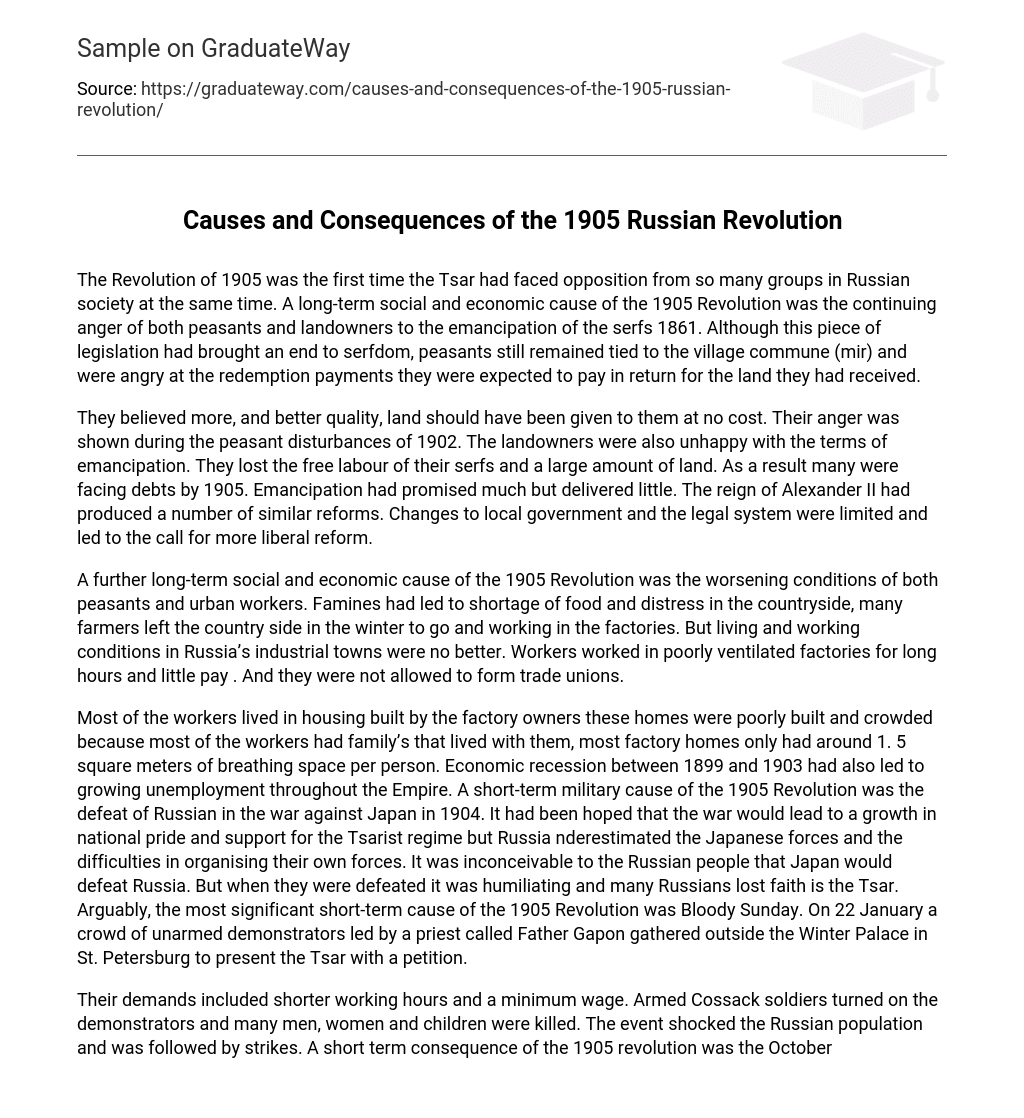The Revolution of 1905 was the first time the Tsar had faced opposition from so many groups in Russian society at the same time. A long-term social and economic cause of the 1905 Revolution was the continuing anger of both peasants and landowners to the emancipation of the serfs 1861. Although this piece of legislation had brought an end to serfdom, peasants still remained tied to the village commune (mir) and were angry at the redemption payments they were expected to pay in return for the land they had received.
They believed more, and better quality, land should have been given to them at no cost. Their anger was shown during the peasant disturbances of 1902. The landowners were also unhappy with the terms of emancipation. They lost the free labour of their serfs and a large amount of land. As a result many were facing debts by 1905. Emancipation had promised much but delivered little. The reign of Alexander II had produced a number of similar reforms. Changes to local government and the legal system were limited and led to the call for more liberal reform.
A further long-term social and economic cause of the 1905 Revolution was the worsening conditions of both peasants and urban workers. Famines had led to shortage of food and distress in the countryside, many farmers left the country side in the winter to go and working in the factories. But living and working conditions in Russia’s industrial towns were no better. Workers worked in poorly ventilated factories for long hours and little pay . And they were not allowed to form trade unions.
Most of the workers lived in housing built by the factory owners these homes were poorly built and crowded because most of the workers had family’s that lived with them, most factory homes only had around 1. 5 square meters of breathing space per person. Economic recession between 1899 and 1903 had also led to growing unemployment throughout the Empire. A short-term military cause of the 1905 Revolution was the defeat of Russian in the war against Japan in 1904. It had been hoped that the war would lead to a growth in national pride and support for the Tsarist regime but Russia nderestimated the Japanese forces and the difficulties in organising their own forces. It was inconceivable to the Russian people that Japan would defeat Russia. But when they were defeated it was humiliating and many Russians lost faith is the Tsar. Arguably, the most significant short-term cause of the 1905 Revolution was Bloody Sunday. On 22 January a crowd of unarmed demonstrators led by a priest called Father Gapon gathered outside the Winter Palace in St. Petersburg to present the Tsar with a petition.
Their demands included shorter working hours and a minimum wage. Armed Cossack soldiers turned on the demonstrators and many men, women and children were killed. The event shocked the Russian population and was followed by strikes. A short term consequence of the 1905 revolution was the October Manifesto. The manifesto was issued by Tsar Nicholas II The October Manifesto addressed the unrest throughout the Russian Empire and pledged to grant basic civil liberties, including personal immunity; and freedom of assembly, association, press, religion, and speech.
As the Duma was only a consultative body, many Russians felt that this reform did not go far enough. Leon Trotsky and other revolutionaries denounced the plan. A long term consequence of the 1905 Russian revolution was the revision of the fundamental laws which transformed the formerly absolutist state into one in which the Tsar agreed for the first time to share his autocratic power with a parliament.
It was enacted on April 23, 1906, on the eve of the opening of the first State Duma. This first-ever Russian Constitution was a revision of the earlier Fundamental Laws, which had been published as the set of laws of the Russian empire in 1832. It was granted during the Russian Revolution of 1905, in a last-ditch effort by the imperial government to preserve its own existence and keep the nation from sliding into all-out anarchy.





